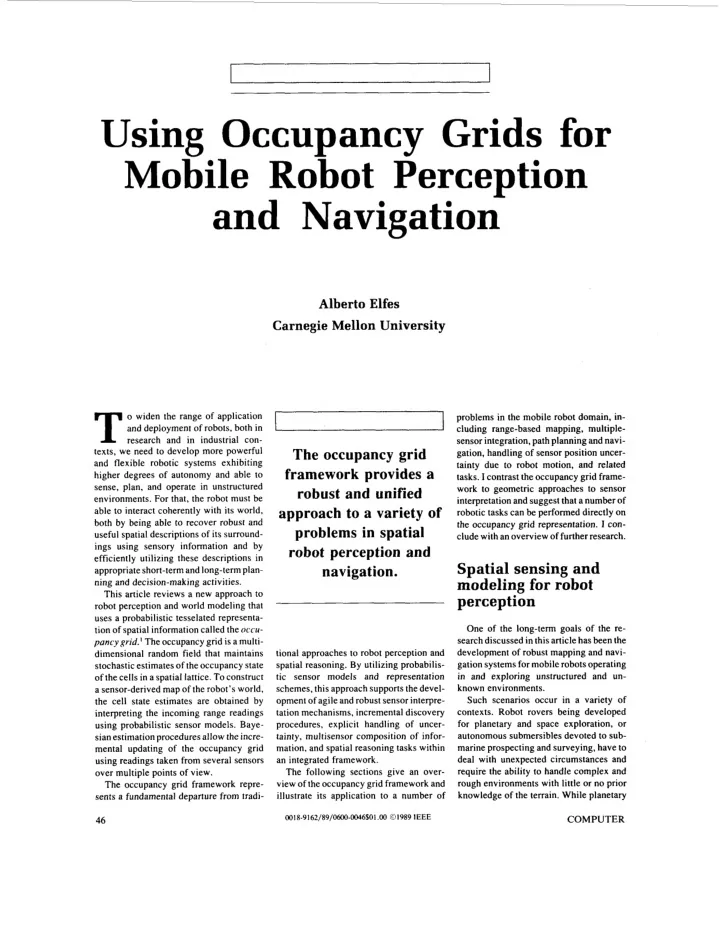

~ zyxwvutsrqponmlkjihgfedcbaZYXWVUTSRQPONMLKJIHGFEDCBA ~~ Using Occupancy Grids for Mobile Robot Perception Carnegie Mellon University zyxwvutsrqponmlkjihgfedcbaZYXWVUTSRQPONMLKJIHGFEDCBA and Navigation Albert0 Elfes T o widen the range of application problems in the mobile robot domain, in- and deployment of robots, both in cluding range-based mapping, multiple- research and in industrial con- sensor integration, path planning and navi- The occupancy grid texts, we need to develop more powerful gation, handling of sensor position uncer- and flexible robotic systems exhibiting tainty due to robot motion, and related framework provides a higher degrees of autonomy and able to tasks. I contrast the occupancy grid frame- sense, plan, and operate in unstructured work to geometric approaches to sensor robust and unified environments. For that, the robot must be interpretation and suggest that a number of approach to a variety of able to interact coherently with its world, robotic tasks can be performed directly on both by being able to recover robust and the occupancy grid representation. I con- problems in spatial useful spatial descriptions of its surround- tion of spatial information called the zyxwvutsrqponmlkjihgfedcbaZYXWVUTSRQPONMLKJIHGFEDCBA clude with an overview of further research. ings using sensory information and by robot perception and pancy zyxwvutsrqponmlkjihgfedcbaZYXWVUTSRQPONMLKJIHGFEDCBA efficiently utilizing these descriptions in Spatial sensing and navigation. appropriate short-term and long-term plan- modeling for robot ning and decision-making activities. This article reviews a new approach to perception robot perception and world modeling that uses a probabilistic tesselated representa- One of the long-term goals of the re- occu- search discussed in this article has been the grid.’ The occupancy grid is a multi- development of robust mapping and navi- tional approaches to robot perception and dimensional random field that maintains gation systems for mobile robots operating spatial reasoning. By utilizing probabilis- stochastic estimates of the occupancy state tic sensor models and representation in and exploring unstructured and un- of the cells in a spatial lattice. To construct schemes, this approach supports the devel- known environments. a sensor-derived map of the robot’s world, Such scenarios occur in a variety of opment of agile and robust sensor interpre- the cell state estimates are obtained by tation mechanisms, incremental discovery contexts. Robot rovers being developed interpreting the incoming range readings for planetary and space exploration, or procedures, explicit handling of uncer- using probabilistic sensor models. Baye- autonomous submersibles devoted to sub- tainty, multisensor composition of infor- sian estimation procedures allow the incre- marine prospecting and surveying, have to mental updating of the occupancy grid mation, and spatial reasoning tasks within 0018-9162/89/0600-06$0l zyxwvutsrqponmlkjihgfedcbaZYXWVUTSRQPONMLKJIHGFEDCBA deal with unexpected circumstances and an integrated framework. using readings taken from several sensors The following sections give an over- require the ability to handle complex and over multiple points of view. view of the occupancy grid framework and rough environments with little or no prior The occupancy grid framework repre- knowledge of the terrain. While planetary illustrate its application to a number of sents a fundamental departure from tradi- .OO 01989 IEEE COMPUTER 46
Recommend
More recommend